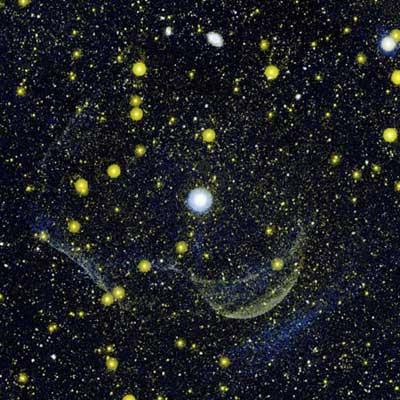Source: Xinhua
02-19-2009 09:29
Special Report: Tech MaxWASHINGTON, Feb. 18 (Xinhua) -- NASA's Galaxy Evolution Explorer has, for the first time, identified dwarf galaxies forming out of nothing more than pristine gas likely leftover from the early universe, according to the results of a new study published by Thursday's journal Nature.
 |
| This composite image released by NASA March 7, 2007 shows Z Cam, a double-star system featuring a collapsed, dead star, called a white dwarf, and a companion star, as well as a ghostly shell around the system. The image combines data gathered from the far-ultraviolet and near-ultraviolet detectors on NASA's Galaxy Evolution Explorer orbiting space telescope on January 25, 2004. Z Cam, one of the first known recurrent dwarf nova is the largest white object in the image, located near the center. The faint bluish streak in the bottom right corner of the image is ultraviolet light reflected by dust that may or may not be related to Z Cam.(Xinhua/Reuters File Photo) |
Dwarf galaxies are relatively small collections of stars that often orbit around larger galaxies like our Milky Way.
The findings surprised astronomers because most galaxies form in association with a mysterious substance called dark matter or out of gas containing metals. The infant galaxies spotted by the Galaxy Evolution Explorer are springing up out of gas that lacks both dark matter and metals. Though never seen before, this new type of dwarf galaxy may be common throughout the more distant and early universe, when pristine gas was more pervasive.
Led by David Thilker of the Henry A. Rowland Department of Physics and Astronomy at The Johns Hopkins University, a team of astronomers spotted the unexpected new galaxies forming inside the Leo Ring, a huge cloud of hydrogen and helium that traces a ragged path around two massive galaxies in the constellation Leo. The cloud is thought likely to be a primordial object, an ancient remnant of material that has remained relatively unchanged since the very earliest days of the universe. Identified about 25 years ago by radio waves, the ring cannot be seen in visible light.
"This intriguing object has been studied for decades with world-class telescopes operating at radio and optical wavelengths," said Thilker, a research scientist. "Despite such effort, nothing except the gas was detected. No stars at all, young or old, were found. But when we looked at the ring with the Galaxy Evolution Explorer, which is remarkably sensitive to ultraviolet light, we saw telltale evidence of recent massive star formation. It was really unexpected. We are witnessing galaxies forming out of a cloud of primordial gas."
In a recent study, Thilker and his team found the ultraviolet signature of young stars emanating from several clumps of gas within the Leo Ring. "We speculate that these young stellar complexes are dwarf galaxies, although, as previously shown by radio astronomers, the gaseous clumps forming these galaxies lack dark matter," he said. "Almost all other galaxies we know are dominated by dark matter, which acted as a seed for the collection of their luminous components -- stars, gas, and dust. What we see occurring in the Leo Ring is a new mode for the formation of dwarf galaxies in material remaining from the much earlier assembly of this galaxy group."
Our local universe contains two large galaxies, the Milky Way and the Andromeda galaxy, each with hundreds of billions of stars, and the Triangulum galaxy, with several tens of billions of stars. It also holds more than 40 much smaller dwarf galaxies, which have only a few billion stars. Invisible dark matter, detected by its gravitational influence, is a major component of both giant and dwarf galaxies with one exception -- tidal dwarf galaxies.
Tidal dwarf galaxies condense out of gas recycled from other galaxies and have been separated from most of the dark matter with which they were originally associated. They are produced when galaxies collide and their gravitational masses interact. In the violence of the encounter, streamers of galactic material are pulled out away from the parent galaxies and the halos of dark matter that surround them.
Because they lack dark matter, the new galaxies observed in the Leo Ring resemble tidal dwarf galaxies, but they differ in a fundamental way. The gaseous material making up tidal dwarfs has already been cycled through a galaxy. It has been enriched with metals -- elements heavier than helium -- produced as stars evolve. "Leo Ring dwarfs are made of much more pristine material without metals," said Thilker. "This discovery allows us to study the star formation process in gas that has not yet been enriched."
Large, pristine clouds similar to the Leo Ring may have been more common throughout the early universe, Thilker said, and consequently may have produced many dark-matter-lacking, dwarf galaxies yet to be discovered.
Editor:Liu Fang
